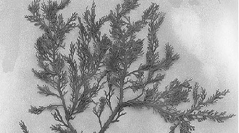

 Cryptogamie, Algologie
25 (4) - Pages 367-396
Cryptogamie, Algologie
25 (4) - Pages 367-396The genus Gracilaria (Gracilariales, Rhodophyta) has long been one of the most taxonomically challenging groups of red algae as a result of the high number of species, small number of distinctive characters, and the high levels of morphological plasticity among vegetative and reproductive features. Recently,DNA sequence phylogenies based on the chloroplastencoded rbcL gene have resolved many systematic questions in this genus. This study provides an rbcL-based phylogeny of the most derived lineage of Gracilaria sensu stricto, the assemblage containing the generitype, G. bursa-pastoris. In this clade, two poorly known and overlooked species of Gracilaria, G. flabelliformis and G. apiculata, were found to be very common members of the genus in the tropical western Atlantic. Gracilaria apiculata belongs to the G. cervicornis complex, a clade composed of highly branched species with terete to compressed main axes, while G. flabelliformis is a member of a clade composed only of Atlantic flat species. Exceedingly distinct phenotypes for each of these species were observed in our circumscription and are described as new subspecies, along with detailed morphological characterization for each of these taxa: G. flabelliformis subsp. aionana subsp. nov. G. flabelliformis subsp. simplex subsp. nov., and G. apiculata subsp. candelabriformis subsp. nov., and G. isabellana nom. nov., a replacement name for G. lacinulata (Vahl) Howe which is a homonym of G. lacinulata (Kützing) Piccone.